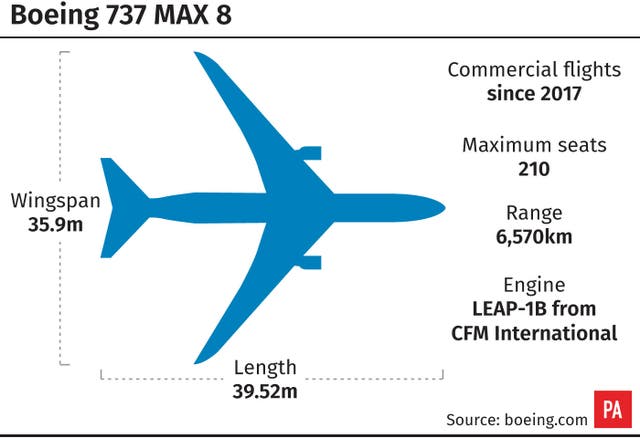
The Ethiopian Airlines crash has put the spotlight on a new generation of 737 Max jetliners from manufacturer Boeing.
The passenger plane that went down after take-off from Addis Ababa was the same model as the Lion Air aircraft that plunged into the sea off Indonesia four months ago.
The Boeing 737 Max 8 is part of a new family of aircraft that Boeing claims is the fastest selling in its history, accumulating nearly 4,700 orders from more than 100 customers worldwide.
The 737 Max 8 aircraft has only been in commercial use since 2017.
In October last year, a Lion Air Boeing 737 Max 8 crashed after taking off from the Indonesian capital Jakarta, killing 189 people.
Indonesian investigators have not determined a cause for the crash.

After the accident Boeing sent a notice to airlines that faulty information from a sensor could cause the aircraft to automatically point the nose down and reminded pilots of the procedure for handling this.
Cockpit data from the Lion Air flight showed the plane’s airspeed indicator had malfunctioned on its last four flights – although the airline initially said this was fixed before the time of the crash.
According to Boeing’s website, the 737 Max 8 model can hold a maximum of 210 seats, is 39.52 metres long, has a 35.9 metre wingspan and range of 6,570 km.
The design sets higher standards in fuel efficiency and performance from its new CFM LEAP-1B engine and includes updated display screens in the flight deck.
The plane that crashed on the way to Nairobi in Kenya was one of 30 purchased by Ethiopian Airlines, and was delivered in November.
The cause of the crash is currently unknown.
In a statement Boeing said it “will be travelling to the crash site to provide technical assistance under the direction of the Ethiopia Accident Investigation Bureau and US National Transportation Safety Board”.
Andrew Blackie, an aviation safety consultant and former commercial pilot, said there was currently not enough information available to make a direct connection between the two crashes.
He explained the Max planes were the fourth generation of the 737 aircraft, that contained new systems built into aircraft shaped and structured like older models.
But he added: “If you look across the history of aviation it’s not hugely unusual for there to be a spike in accident rates when a new aircraft type is introduced into service.”
Mr Blackie said pictures of the crash showed there was a “high energy impact” but he expected black box data recorders to be found.
“They may well find that they will come to the UK because the facilities here are extremely good for downloading data from recorders in accidents,” he said.
He said Ethiopia would lead an investigation into the crash as the country where it occurred but it was not unusual for other nations to be invited to participate, including the US where Boeing is based.

In the case of the Lion Air crash, Mr Blackie said aircraft system changes “have perhaps not been particularly well explained to the operating crew”.
He said pilots with a lot of experience of older 737 models might be at a “disadvantage” when using the new aircraft.
“They have a model in their mind… they have built up an expectation of what each switch does, of how the airplane is going to react when you move a control.
“Do the crew realise that this bit doesn’t actually work the same way as it used to on the last one?”
Mr Blackie said that to have 35 nationalities among the Ethiopian Airlines plane’s passengers was not unusual.
“It reflects Ethiopian Airlines’ development in the market, they are becoming a well connected hub for that area of Eastern Africa,” he said.
Mr Blackie said there had been a “phenomenal” reduction in plane accidents in sub-Saharan Africa, with the number of fatal crashes falling by around 85% in the 10 years to 2016.
“This event is all the sadder for that,” he added. “Hopefully this isn’t the beginning of a trend in the wrong direction.”

Enjoy the convenience of having The Sunday Post delivered as a digital ePaper straight to your smartphone, tablet or computer.
Subscribe for only £5.49 a month and enjoy all the benefits of the printed paper as a digital replica.
Subscribe